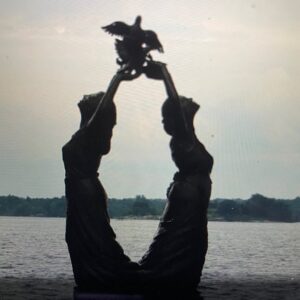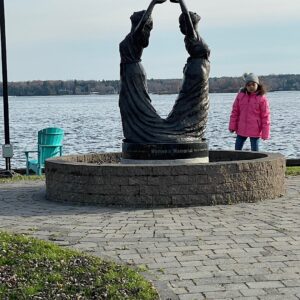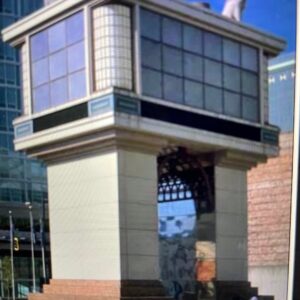Why We Like Big Things in Public Art
In a conversation with a well known local journalist, I asked her to name the number of statues she knows that are of women in Canada. Together we could only think of three or four in the whole country.

The Canadian Women’s Foundation has a list of statues and monuments to women and mention four statues nationally. I would add in a fifth statue to the list, the Emily Carr statue in Victoria.
A statue is described as a “free-standing sculpture” where a realistic life size person or animal is depicted either by carving or by cast. They have been around for millennia, and one is often the first object taught in university art history classes.
In Roman times, having a statue of yourself depicted great status, and having a public statue of yourself showed you were effective in politics or business. In the 20th century many statues are built to commemorate important events and figures. It was not until the 1920’s and 1930’s that statues started to have more abstract forms. Henry Moore was one of the British artists that brought abstract art into mainstream acceptance.
In Brockville Ontario a sculpture on Blockhouse Island attracts young children to it, mainly girls. It is this one below, and it would be a sixth entry to the Canadian list of statues about women.
The scale of it is close to human size, and approachable. It is also local design, being the creation of secondary school students at the Thousand Islands Secondary School.
Installed in a 2011 ceremony called the “Voices of Hope” it is a tribute to women who experience violence and to the people who work to stop it. It is a difficult subject and sometimes a taboo topic, but is approachable and accessible, with the two figures holding birds aloft. It is described as a “symbol of hope for a violence free community”.


There is little written in the newspapers about this statue, but the fact it exists brings forward a topic that should be centred, and allows for the contemplation of the topic in a park environment.
Today, November 25 is also the United Nations designated day for the Elimination of Violence against Women. There is a monument in Thornton Park called the Marker of Change recognizing the 14 women killed at the Ecole Polytechnique in Montreal, but it is not figurative. It contains a series of 14 pink granite benches recognizing the 14 lives.
While there is much discussion about statues that need contextual interpretation to be relevant, there are others that probably should be put away in a museum or gallery that can explore why it was appropriate for the time, and what cultural reference it has for social mores of its era. An example is the 70 year old Theodore Roosevelt statue which is politely called “troubling” . The statue is being removed from its location in front of the Museum of Natural History in New York and shipped to North Dakota.
Vancouver itself is not without controversy about statues. One example is the Terry Fox Monument that was constructed in 1984 near BC Place. Vancouver Sun’s Jeff Lee describes it this way “I’ve yet to find more than a handful of people who appreciate the architectural folly with its glass fibre lions and unworking projection screen atop a fat arch. Most people have a visceral reaction, still hating the Franklin Allen-designed monument. After 27 years, the pink stucco-style faux Beaux-Artes memorial still evokes a negative reaction from many.”

The post-modernist monument designed by Franklin Allen was selected by a committee headed up by Architect Arthur Erickson. The monument is very 1980’s, with its very shell pink exterior and neoclassical design.
No one really knew what it was or who it represented. This YouTube video below has some typical responses.
It was demolished and replaced in 2011 by a more figurative sculpture of Terry Fox designed by artist and author Douglas Coupland.
And it’s the Coupland work on that spot today.You can see the YouTube video below unveiling Douglas Coupland’s Terry Fox sculpture with former Premiere Christy Clark doing the honours.
images: VancouverSun & sandyjames
